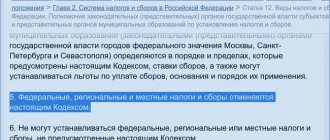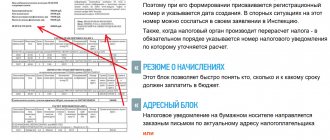Published by: Marina Shmeleva
Category: Finance and Law
4 316
We answer the question whether individual entrepreneurs can switch to NIT (professional income tax) and how to do it. NAP is intended for individuals engaged in independent business. Individual entrepreneurs on NAP will be able to re-register in different regions at different times.
Thus, in Tatarstan, Moscow, Moscow and Kaluga regions, the new tax regime began to operate on January 1, 2022. In Crimea, Komi, Buryatia, Dagestan, Khakassia, Astrakhan, Vladimir regions - from January 1, 2022. Adyghe entrepreneurs took advantage of the innovation from July 3, 2022.
A complete list of regions where the pilot tax project was launched and the dates of its entry into force is located on the official website of the Federal Tax Service.
The payer of the tax in question has the right to work simultaneously in several regions of the country. The tax amount will go to the budget of the locality specified in the “My Tax” application upon registration. 37% of the payment covers the individual entrepreneur’s health insurance, the remaining 63% goes to the local treasury.
Individual entrepreneur on NAP - who can switch to this taxation system?
Entrepreneurs operating without forming a legal entity (individual entrepreneurs, self-employed) and living in those regions of Russia where this experiment will operate or is already operating will be able to take advantage of the new tax regime. The transition of individual entrepreneurs to NAP is not mandatory.
To implement it, a number of conditions must be met:
- Entrepreneurial activity is carried out by a person without an employer or the use of hired workers.
- A person derives profit from the exploitation of his own property or personal activities.
- The activity is not included in the list of exceptions not covered by the innovation. The list was approved by Art. 4.6 Federal Law - 422.
- The amount of annual income is not higher than 2.4 million rubles . If this indicator is exceeded, the individual entrepreneur is obliged to pay tax according to the rules of the taxation system under which he worked previously. Self-employed people who do not have individual entrepreneur status will pay personal income tax. Annual income can be checked through the application. At the beginning of the next tax year, a person can again switch to IPA.
For an example of the use of NPD, you can consider the work of a massage therapist at home, photography and video shooting on order, the sale of food and non-food products of your own making, the services of a toastmaster, designer, etc.
At the same time, it is important to understand that if the individual entrepreneur has switched to NAP, then you DO NOT lose your status as an individual entrepreneur. You do NOT become self-employed, but simply use the tax system.
The procedure for switching individual entrepreneurs to NPD is completely reversible. However, there is a nuance. Read the article carefully so you don't miss it! You can ask questions in the comments or leave a request through the form on the website.
Features of NAP for individual entrepreneurs
NPI or professional income tax is a regime that was created specifically for the self-employed. This tax system was introduced in the regions of the Russian Federation in stages, but in 2022 it is valid everywhere.
Not only ordinary self-employed citizens, but also individual entrepreneurs can pay professional income tax. The conditions for applying the regime are the same for both, so you can switch to NPA while remaining in the status of an individual entrepreneur.
Let us list the main features of the tax on professional income:
- annual income should not exceed 2.4 million rubles;
- it is allowed to provide services (with some exceptions), perform work and sell goods of one’s own making;
- You cannot hire workers under employment contracts, but you can hire performers under a civil process agreement;
- a cash register is not used, the check is sent through the “My Tax” application;
- you can work with both individuals and legal entities;
- the tax rate is 4% or 6% (depending on the client category);
- the tax is calculated automatically at the end of the month and paid based on a notification from the Federal Tax Service;
- there is no reporting;
- It is not necessary to pay insurance contributions for pensions, but in this case the length of service for the pension does not count.
As you can see, the simplified tax system and the NPD are similar to each other (meaning only the “Income” option). And the most important differences due to which individual entrepreneurs switch to paying professional income tax are the opportunity not to pay contributions for themselves and the right not to use cash registers.
But if freedom from a cash register is a clear advantage of the NAP, then the right to refuse contributions is not always a benefit. After all, on the simplified tax system for income, the transferred contributions are deducted from the calculated tax, but on the NAP there is no such possibility. Therefore, with a certain income and an equal rate of 6%, the simplified tax system Income option can sometimes be more profitable.
Free tax consultation
Tax rate on professional income
The NPA tax rate is:
- 6% if the subject is settling with a legal entity. face;
- 4% - if with physical. face.
The client's status is indicated in the receipt, which, in turn, is created electronically in the My Tax application. Rates and payment amounts are determined automatically there.
The application contains information about accruals and preliminary amounts of tax payments. The user can view it at any time. According to the provisions of Federal Law 422, there are no plans to change rates over the next 10 years.
What taxes will an individual entrepreneur not pay on NAP and what kind of reporting will he submit?
The type of tax under consideration has an advantage over other taxation systems, since it replaces the following types of mandatory payments:
- VAT (with the exception of VAT levied on objects imported into the territory of the Russian Federation);
- Personal income tax (this rule covers the income of an individual, which could conditionally be subject to personal income tax);
- You don’t have to pay insurance premiums to compulsory health insurance and compulsory medical insurance for yourself. That is, you save on average 40,000 rubles per year. The amount is small, but still nice.
A huge advantage of the transition of individual entrepreneurs to NAP is the COMPLETE lack of reporting. Have you used the services of an accountant or services like Elba? You can safely forget about them! There is no need to submit declarations, show a book of income and expenses, etc.
All you need to do is pay taxes through the special “My Tax” application. It is available on the App Store and Google Play. The tax is calculated automatically, but payment is made manually. This allows you to avoid incorrect debits of funds. Read on and find out how the application works.
About the My Tax app
The program was developed for tax payers as the main means of interaction with tax authorities. With its help, the entrepreneur will be able to generate and send checks to clients, track deductions, not miss payment deadlines, pay taxes, etc. The application frees you from the need to visit tax authorities in person, maintain an online cash register and submit returns.
We recommend reading: What subsidies are there for businesses and how to get them?
According to clause 2.2 of Art. 5 Federal Law-54, NPD payers do not use cash register equipment. Based on the essence of this law, we can conclude that they are not entrepreneurs in the full sense of the word, and they retain the status of individuals. However, they are still required to issue checks to their clients. This obligation is enshrined in clause 1 of Art. 14 FZ-422.
You can register in the application:
- according to your passport – through any mobile device;
- by TIN, login and password – through the “Taxpayer’s Personal Account”;
- by cell number, SNILS or email address - through “Government Services”.
Citizens who do not have a smartphone can register in the application through banking organizations that interact with the Federal Tax Service as part of the NAP implementation program - Sberbank of Russia, Alfa-Bank, VTB, Vesta Bank. A complete list of authorized credit organizations is posted on the official website of the Tax Service. Here you can also enter the personal account of the payer of the NPA “My Tax”.
Issuing a check
To generate a check, the user must:
- On the main page of the application, click the “New sale” button.
- In the “New sale” section, indicate the cost of the service and its name. If the basis for the provision of a service is a contract, the phrase “under contract” is included in this period.
- Indicate the date of sale. The “calendar” option will allow you to select the desired date.
- Enter the client's status - individual or legal entity, enter his TIN, name (full name).
- Click the “Issue check” button, then use the “Send to buyer” button to perform the same operation. Through the application, checks are sent to the client’s email, WhatsApp or other messenger. To complete the sending, click the “Finish” button, after which the payment document will be at the disposal of the latter. If technically possible, the check can be printed and submitted in paper form.
A payment document must be issued immediately upon receipt of money. Failure to comply with this rule entails an administrative fine in the amount of 20% of the amount of the untimely recorded settlement.
If a similar violation is committed within six months after paying the first fine, the second fine will be 100% of the specified amount.
However, there is an exception to the rule when income can be recorded after some time has passed, but not later than the 9th day of the month following the billing month.
It applies to commission and agency service agreements (for example, in situations where a lawyer is hired as an intermediary to represent the interests of the company to third parties).
How to transfer IP to NPD
The transition of individual entrepreneurs to NPD is as simple as possible. There is no need to fill out any paper applications. To begin using the new tax regime, an entrepreneur must register in the My Tax application and receive a confirmation email from the Tax Service.
After this, he automatically becomes a NAP payer. However, the simplified taxation system remains valid.
Therefore, it is necessary to write a refusal from the simplified tax system in a certain form, and within 30 days submit the form to the tax office at the place of registration. Otherwise, you will pay taxes under the NAP and the simplified tax system at the same time.
What is better – close an individual entrepreneur and become self-employed or switch to NAP
The global economic crisis caused by the coronavirus pandemic has deprived many entrepreneurs of income. But you have to pay insurance premiums for yourself in any case; in 2022 it is 40,874 rubles.
Therefore, many entrepreneurs whose business was affected by the imposed restrictions simply ceased their activities by filing an application P26001. And now, as an alternative, they are considering switching to self-employment with an individual entrepreneur.
Overall, this is a good option if you plan to provide services only to the public. But if you want to work with organizations or individual entrepreneurs, then for them the status of self-employed in the contract carries with it certain risks.
- Firstly, if the party to the contract is an ordinary self-employed person, the customer must ensure that he is not deregistered as a payer of NAP. After all, if the performer unexpectedly loses his self-employed status, he becomes an ordinary citizen for whom insurance premiums must be paid and personal income tax must be withheld from him.
- Secondly, the Federal Tax Service checks such contracts to ensure that an employee who has worked for this customer for the last two years does not appear in them as a self-employed person. And, for obvious reasons, no one wants to arouse additional interest from tax officials.
- Thirdly, if a self-employed person wants to rent commercial real estate for his business, the owner may refuse to rent him. The reason is that shopping and business centers, as a rule, only accept payment through a bank account. In this case, they do not need to issue a cash receipt. And in order to accept payment from a self-employed citizen who does not have individual entrepreneur status, you will have to use a cash register. Few landlords will do this, unless they use the cash register for other situations.
Therefore, the customer, a legal entity or individual entrepreneur, all other things being equal, will choose to work with an individual entrepreneur rather than with an ordinary self-employed person. This is clearer and there are fewer risks.
There is one more important nuance for the sake of which it is worth maintaining the status of an individual entrepreneur, and not going into self-employment. Not all types of activities of individual entrepreneurs are available to ordinary self-employed people. The simplest example is a taxi permit. Although the NAP law does not directly prohibit this direction, there are other regulations in accordance with which only individual entrepreneurs or organizations can obtain a taxi permit. The same applies to licensed types of activities - licenses are not issued to self-employed citizens.
As for exceeding the income limit for NAP, here too the individual entrepreneur wins. As soon as this happens, the individual entrepreneur will be able to return to the simplified regime within 20 days and pay tax at a rate of 6%.
But an ordinary self-employed person, after exceeding the limit, will no longer be able to work on NAP, so his income will continue to be taxed at a rate of 13%. Unless, of course, he registers an individual entrepreneur, which will give him the opportunity to work at reduced rates. So you need to make a decision to switch to self-employment using the simplified tax system carefully, preferably after consultation with an accountant.
We’ll tell you in more detail about how to switch from the simplified tax system to professional tax, and when this can be done.
How to switch to NPD with the simplified tax system - we write a refusal from the simplified tax system
According to the law, the professional income tax for individual entrepreneurs applies only to self-employed people. Entities operating under a simplified taxation system are not considered as such.
For those who are interested in how to switch from the simplified tax system to the NAP, let us say that this is very simple to do. You just need to register in the application and start recording your income in it.
Within 30 days after the transition of the individual entrepreneur to the NAP has occurred - registration in the application is considered a transition, the Individual Entrepreneur must submit to the local branch of the Federal Tax Service a notification about the cessation of using the previous taxation mechanism and the transition to the NAP.
The transition of individual entrepreneurs to NAP is a form of refusal from the simplified tax system
The procedure for submitting such a document is established by letter of the Federal Tax Service of the Russian Federation dated January 10, 2019 No. SD-4-3/ [email protected] , the form of notification is determined by the order of the Federal Tax Service of Russia dated November 2, 2012 No. ММВ-7-3/ [email protected]
You can download the form here: Form for transition to NAP
You can submit your refusal from the simplified tax system to the Tax Service:
- personally;
- through a representative by proxy;
- by mail with a description of the attachment;
- through the “Taxpayer’s Personal Account” on the official website of the Federal Tax Service (in the “My Taxation System” section).
Very important! If the individual entrepreneur has switched to the NAP and a refusal from the simplified tax system has been written, then you will be able to return back from the NAP to the simplified tax system (or to another taxation system) only after 6 months.
When can you switch from the simplified tax system to the NAP - deadlines
An important addition that anyone who wants to change their tax regime should know about. Almost all entrepreneurs are sure that changing the tax regime is allowed only at the end of the calendar year after declaring profits, paying pension and insurance fees. This will take several days, depending on the previously used system and the new one.
Of course, this stops many who would like to switch from the Patent or the General Regime and the simplified tax system to the NAP. But not everything is as sad as it seems.
The government took care of the self-employed and individual entrepreneurs who found themselves in a difficult situation (especially due to Covid) and removed the timing clause from the rules for the transition from any taxation system to the tax for the self-employed (SPE). In 2022 (what will happen next is still unknown), you can change the simplified tax system to the NAP at any time - even at the end of the year, even in the middle.
How to cancel NPA?
Cancellation of NTD is carried out through the “My Tax” application. In the settings, select the “Deregister NAP” button. After clicking on it, the program will offer to indicate one of two reasons for termination of registration - refusal to apply the special tax regime, loss of the right to apply the special tax regime. The user selects the appropriate option.
We recommend reading: Reorganization of a legal entity: procedure and forms of company reorganization
At the next stage, the application will require confirmation of the intention to deregister. To do this, you need to click the “Confirm” button located in the lower sector of the page with the personal data of the individual entrepreneur. Then the program will inform you that the process of deregistering the subject from the NPA register has been started. After a few minutes, the user will receive a notification that registration has been terminated.
Important! Before closing, all prepaid checks for which services have not been rendered must be voided. Otherwise, the entrepreneur will have to pay taxes on them.
Why are they abandoning the simplified tax system?
Refusal from simplification can be voluntary or forced. We think it would be unnecessary to decipher these concepts in detail - in one case, we make a decision based on our own, and in the other, you are forced by law to abandon the simplified tax system. It’s better to take a closer look at the exact reasons why failure occurs in both options.
Voluntary refusal of the simplified tax system
Most often, entrepreneurs decide to switch to other taxation systems for the following reasons:
- problems with VAT when buying and selling;
- opening new branches or representative offices;
- the need to increase the number of employees;
- merger of companies;
- desire to join the partnership.
Of course, these are not all the reasons, but only the most common ones.
Example: A company begins to work with customers using OSNO and places its main emphasis on them. And for those, in turn, it is simply not profitable to cooperate with enterprises using the simplified tax system, because they cannot deduct VAT and therefore overpay taxes.
Forced refusal to use the simplified tax system
Forced refusal occurs due to the fact that the company loses the right to use the “simplified” system. Here are the cases in which this happens:
- Exceeding the income limit. When your income for the reporting period exceeds 112,500,000 rubles.
- Exceeding the residual value of fixed assets. It also should not be higher than 150,000,000 rubles in order to be eligible for the simplified tax system.
- Excess number of employees. During the reporting period, the number of employees should not exceed 100 people.
- Creation of branches. Companies with branches lose the opportunity to use the simplified tax system.
- Share of participation of other organizations. It is prohibited to apply the simplified tax system to organizations in which the share of participation of other organizations is more than 25%.
- Participation in a simple partnership agreement. Taxpayers who are parties to a simple partnership agreement (joint activity agreement) or a property trust management agreement use income reduced by the amount of expenses as an object of taxation.
Example: The company was doing well and had the opportunity to increase the number of sales points and expand production. The number of employees begins to exceed 100 people, which means that applying the simplified tax system further becomes impossible.
The procedure for paying taxes under the NPA system
You do not need to calculate the tax amount yourself. The application determines it automatically depending on the payer’s status and the availability of the right to a tax deduction. The only thing the user is required to do is to issue an electronic receipt for each payment received as part of commercial activities.
Based on the information contained in the receipts, the IRS software generates receipts. They contain QR codes for payment through mobile devices and electronic payment systems.
The tax is paid in one of the following ways:
- by bank card – in the “My Tax” application;
- using the payment details of the receipt and QR code – via Internet banking;
- according to your passport and receipt details - in cash at the cash desk.
Information that the tax has been paid is received in the application within:
- 10 working days if payment was made from a bank card;
- 20 working days if payment was made in cash through the cash desk of an authorized credit institution.
How to pay NTD through “My Tax”
To make a payment in the application, on the main page you need to go to the “Taxes” tab, and then in the window that opens, go to the “Proceed to Payment” tab. NAP must be paid by the 25th day of the month following the billing month.
The first tax period begins on the day of registration and is valid until the end of the next month. There is no need to track deadlines yourself, since the Federal Tax Service, through the application, notifies payers of the accrued amounts of non-taxable income and receipts with details.
As part of the NAP, the state provides for the possibility of deduction. It should be distinguished from the benefit that entities are entitled to when selling property or paying personal income tax.
The NAP deduction is a kind of advance allocated by the state to reduce the tax burden. Its amount is 10,000 rubles, and it is provided once for the entire period of work of the self-employed. The deduction itself does not have a physical monetary value, i.e. is not issued to the payer.
The benefit works as follows. For a month, an individual entrepreneur receives a certain amount of money from clients, which is taxed at a rate of 4% or 6%. The 1% share of the rate will be paid by the state, i.e. the self-employed will pay not 4% or 6%, but 3% or 5%, respectively. In this way, NAP will be paid until the total amount of deductions reaches 10,000 rubles.
There is only one catch in the taxation system - the income limit is no more than 2.4 million rubles per year. If you earn more, then NPA is not suitable for you. Otherwise, it is very profitable and convenient for beginning entrepreneurs.
Legal article from:
STS or NAP - a short summary
The tax for the self-employed has become interesting to many individual entrepreneurs for a number of reasons:
- there are no obligations to declare income;
- no need to pay insurance/pension contributions;
- favorable tax rates - 4% when providing services to individuals and 6% when working with a legal entity;
- online generation of a check that can be cancelled;
- no need for any CCT;
- no profit - no tax.
However, there is also another side to the coin.
- You will not be perceived as an individual entrepreneur by banks (not all, but still...), but only as a self-employed person.
- Your pension experience will stop unless you contribute voluntarily.
- You cannot earn more than 2.4 million rubles a year, which is not affordable for everyone anyway.
- You are not allowed to trade or hire workers even under a civil contract.
If NPD is your option, then feel free to use it. It's never too late to refuse and return to the simplified tax system. So why pay more when you can pay less or nothing at all?






